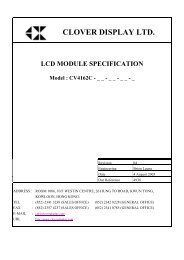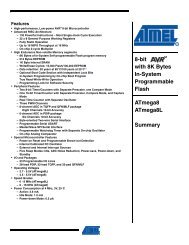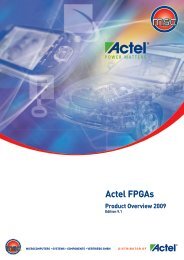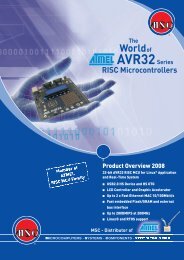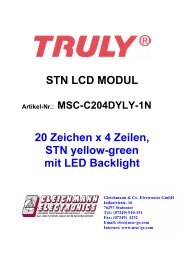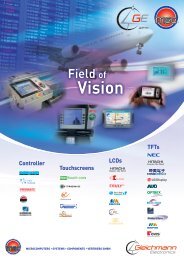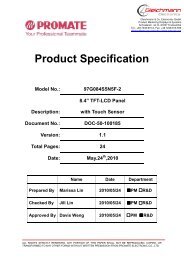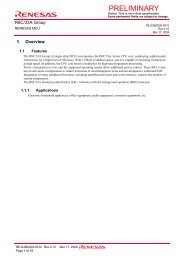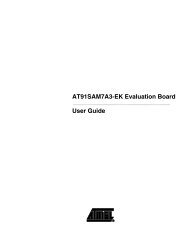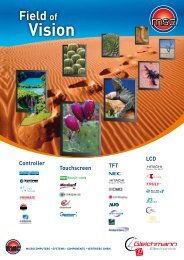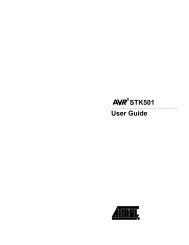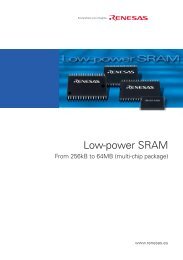SL811HS Embedded USB Host/Slave Controller
SL811HS Embedded USB Host/Slave Controller
SL811HS Embedded USB Host/Slave Controller
Create successful ePaper yourself
Turn your PDF publications into a flip-book with our unique Google optimized e-Paper software.
<strong>SL811HS</strong><br />
Endpoint Packet Status [Address a = (EP# * 10h)+3, b = (EP# * 10h)+Bh]. The packet status contains information relative to<br />
the packet that is received or transmitted. The register is defined as follows:<br />
Table 25. Endpoint Packet Status Reg [Address EP0a/b:03h/0Bh, EP1a/b:13h/1Bh, EP2a/b:23h/2Bh, EP3a/b:33h/3Bh]<br />
7 6 5 4 3 2 1 0<br />
Reserved Reserved Overflow Setup Sequence Time-out Error ACK<br />
Bit Position Bit Name Function<br />
7 Reserved Not applicable.<br />
6 Reserved Not applicable.<br />
5 Overflow Overflow condition - maximum length exceeded during receives. This is considered a<br />
serious error. The maximum number of bytes that can be received by an endpoint is determined<br />
by the Endpoint Base Length register for each endpoint. The Overflow bit is only<br />
relevant during OUT Tokens from the host.<br />
4 Setup '1' indicates Setup Packet. If this bit is set, the last packet received was a setup packet.<br />
3 Sequence This bit indicates if the last packet was a DATA0 (0) or DATA1 (1).<br />
2 Time-out This bit is not used in slave mode.<br />
1 Error Error detected in transmission, this includes CRC5/16 and PID errors.<br />
0 ACK Transmission Acknowledge.<br />
Endpoint Transfer Count [Address a = (EP# * 10h)+4, b =<br />
(EP# * 10h)+Ch]. As a peripheral device, the Endpoint<br />
Transfer Count register is only important with OUT tokens<br />
(host sending the slave data). When a host sends the<br />
peripheral data, the Transfer Count register contains the<br />
difference between the Endpoint Base Length and the actual<br />
number of bytes received in the last packet. In other words, if<br />
the Endpoint Base Length register was set for 64 (40h) bytes<br />
and an OUT token was sent to the endpoint that only had 16<br />
(10h) bytes, the Endpoint Transfer Count register has a value<br />
of 48 (30h). If more bytes were sent in an OUT token then the<br />
Endpoint Base Length register was programmed for, the<br />
overflow flag is set in the Endpoint Packet Status register and<br />
is considered a serious error.<br />
Table 26. Endpoint Transfer Count Reg [Address EP0a/b:04h/0Ch, EP1a/b:14h/1Ch, EP2a/b:24h/2Ch, EP3a/b:34h/3Ch]<br />
7 6 5 4 3 2 1 0<br />
EPxCNT7 EPxCNT6 EPxCNT5 EPxCNT4 EPxCNT3 EPxCNT2 EPxCNT1 EPxCNT0<br />
<strong>USB</strong> Control Registers<br />
The <strong>USB</strong> Control registers manage communication and data<br />
flow on the <strong>USB</strong>. Each <strong>USB</strong> device is composed of a collection<br />
of independently operating endpoints. Each endpoint has a<br />
The Control and Status registers are mapped as follows:<br />
Table 27. Control and Status Register Map<br />
Register Name<br />
Control Register 1<br />
Interrupt Enable Register<br />
<strong>USB</strong> Address Register<br />
Interrupt Status Register<br />
Current Data Set Register<br />
Control Register 2<br />
SOF Low Byte Register<br />
SOF High Byte Register<br />
DMA Total Count Low Byte Register<br />
DMA Total Count High Byte Register<br />
unique identifier, which is the Endpoint Number. For more<br />
details about <strong>USB</strong> endpoints, refer to the <strong>USB</strong> Specification<br />
1.1, Section 5.3.1.<br />
Address (in Hex)<br />
05h<br />
06h<br />
07h<br />
0Dh<br />
0Eh<br />
0Fh<br />
15h<br />
16h<br />
35h<br />
36h<br />
Document 38-08008 Rev. *D Page 14 of 32<br />
[+] Feedback



